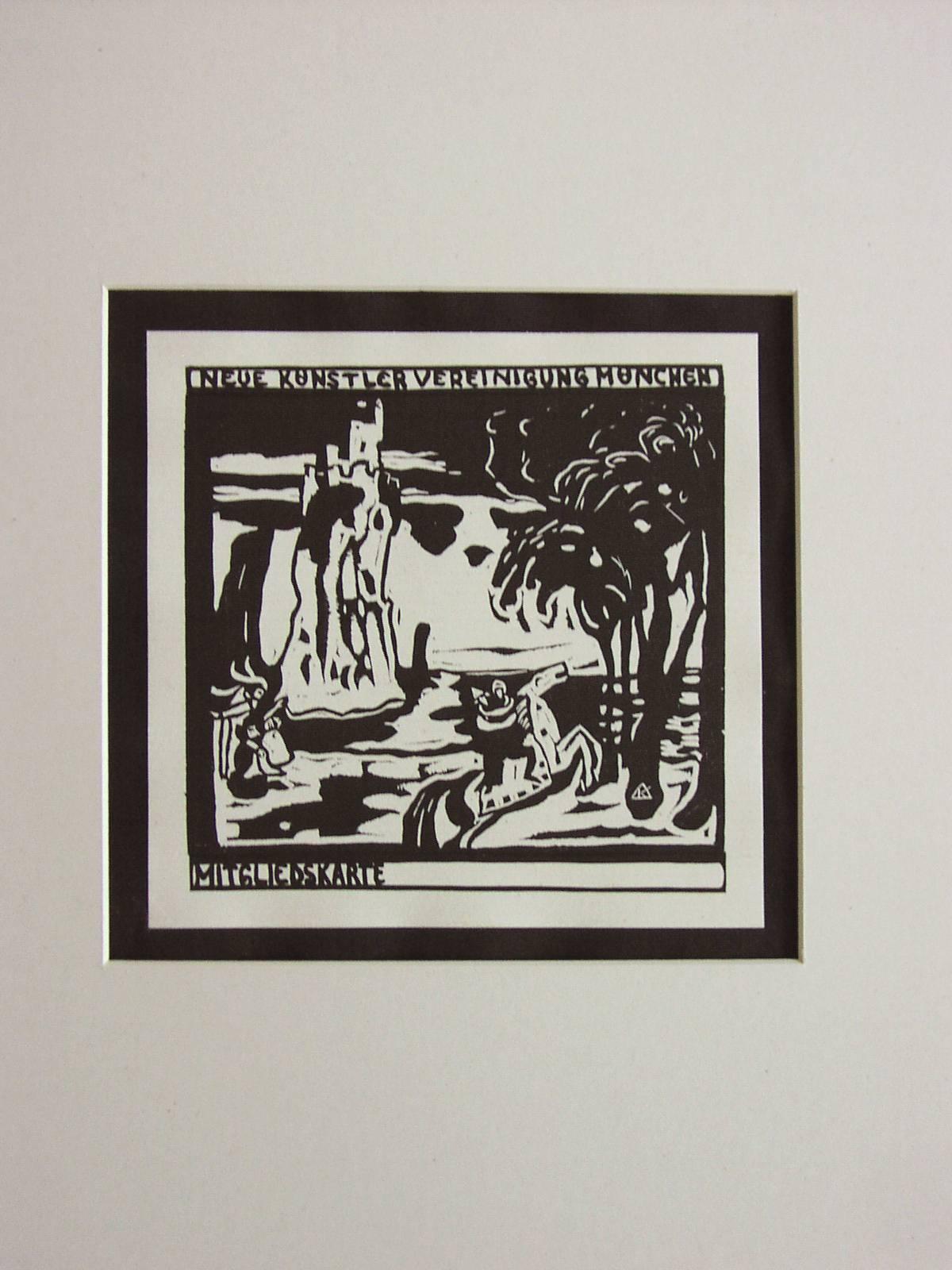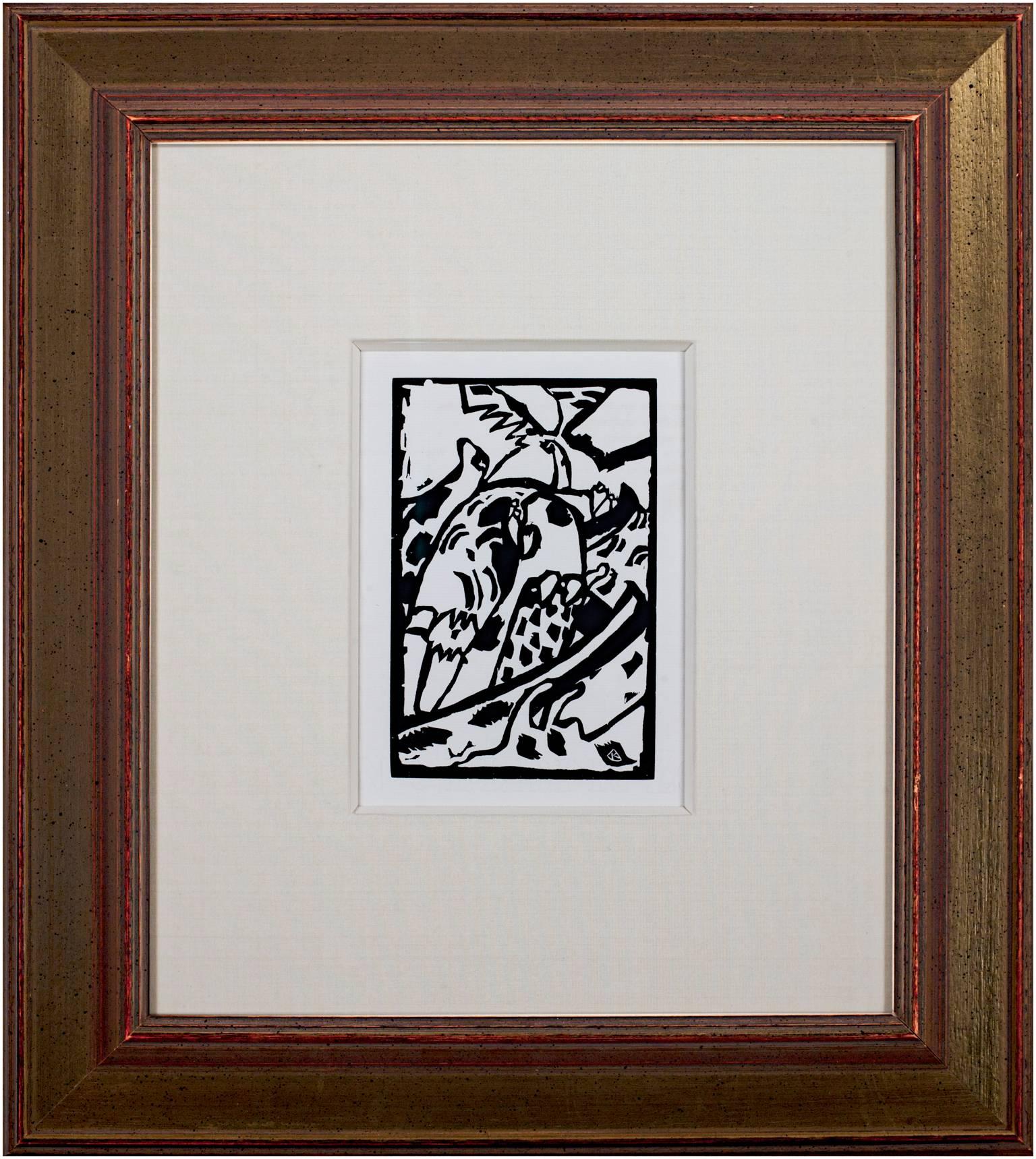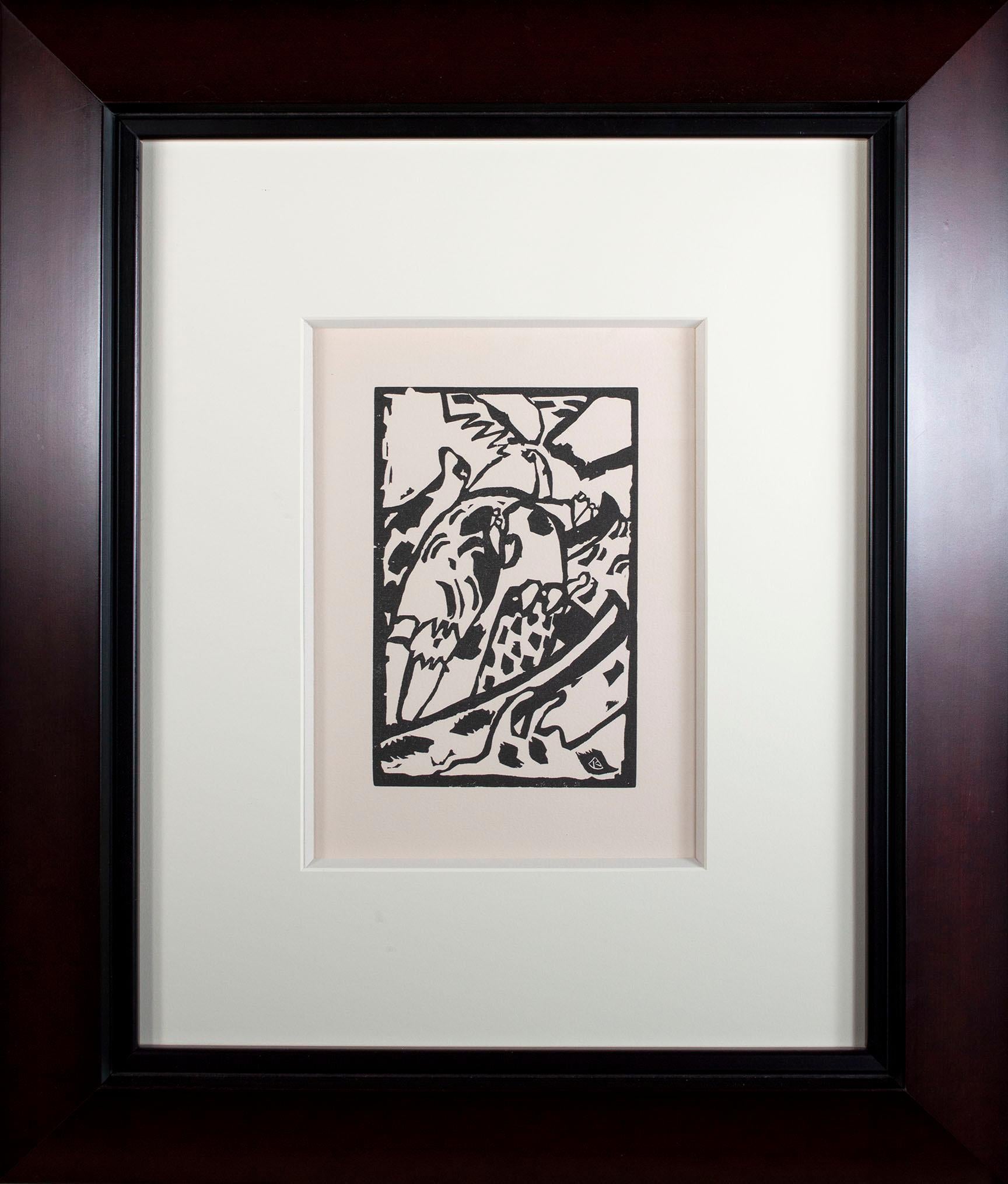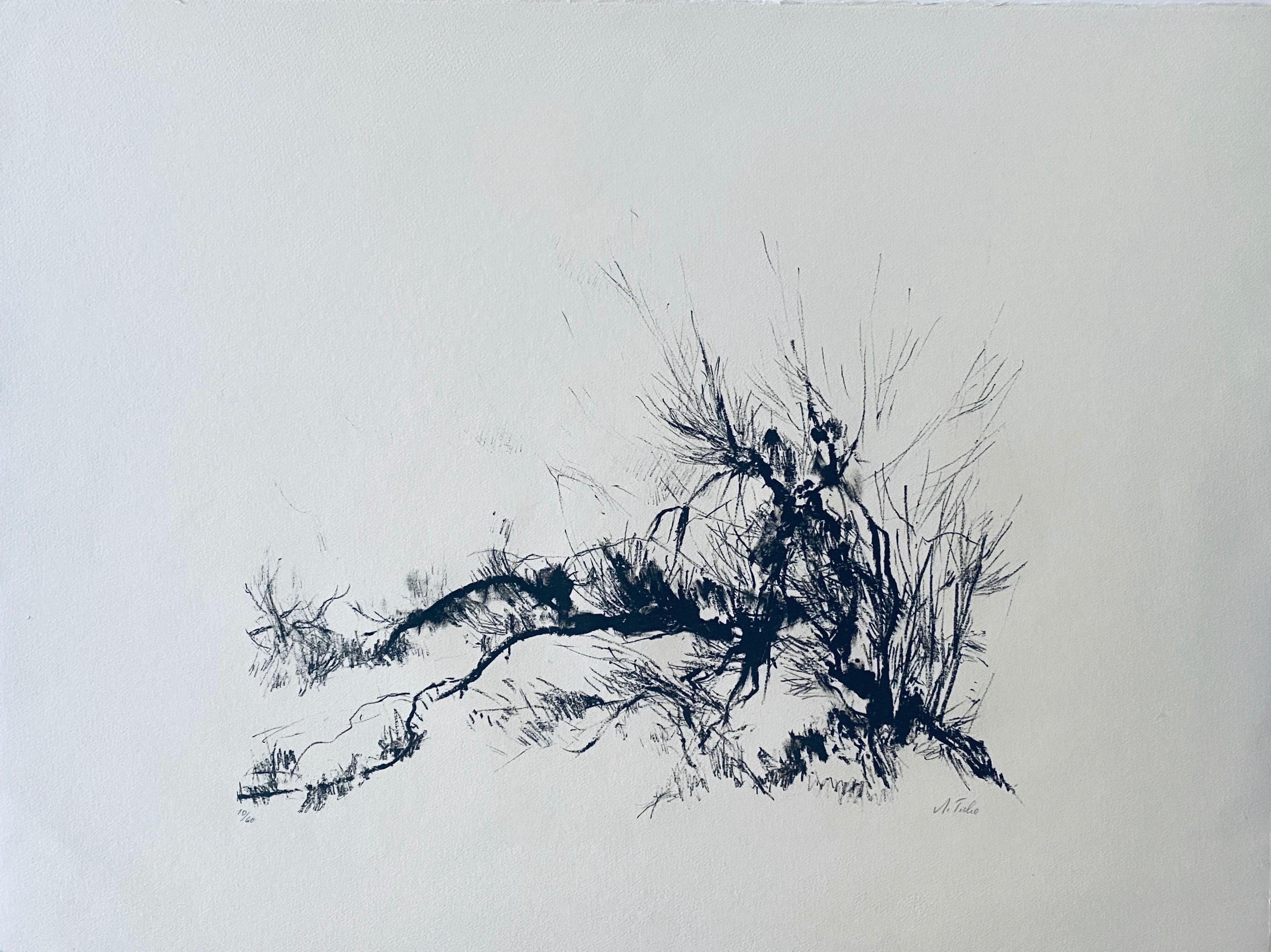Items Similar to 'Nuits de la Fondation Maeght' original lithograph event poster
Want more images or videos?
Request additional images or videos from the seller
1 of 8
(after) Wassily Kandinsky'Nuits de la Fondation Maeght' original lithograph event poster1971
1971
About the Item
This poster, published in 1971 for the Fondation Maeght, proudly boasts a lithographic rendering of Wassily Kandinsky's 1922 mural plans for the Juryfreie exhibition in Germany. It was in 1922 that Kandinsky was invited to teach at the Bauhaus in Weimar, Germany. There, he threw himself into an intensive period of artistic and theoretical production. With his students, the painter worked on monumental decors, including this mural cycle. The Bauhaus was closed in 1933 under the risign threat of Nazism, and Kandinsky ended this creative period and left for France. The composition places bursting forms of color against a dark black background, emblematic of the modern master's expressionist style.
This poster has been cut down from its original size. The text originally at the bottom is included on the back of the frame.
21 x 22.13 inches, artwork
29.5 x 30.88 inches, frame
Published by Imprimerie Arte Paris
Framed to conservation standards using archival materials including 100 percent rag mounting, UF5 Plexiglas to inhibit fading, and housed in a silver finish wood moulding.
Wassily Wassilyevich Kandinsky (16 December 1866 – 13 December 1944) was an influential Russian painter and art theorist. He is credited with painting the first purely abstract works. Born in Moscow, Kandinsky spent his childhood in Odessa. He enrolled at the University of Moscow, studying law and economics. Successful in his profession—he was offered a professorship (chair of Roman Law) at the University of Dorpat—he began painting studies (life-drawing, sketching and anatomy) at the age of 30.
In 1896 Kandinsky settled in Munich, studying first at Anton Ažbe's private school and then at the Academy of Fine Arts. He returned to Moscow in 1914, after the outbreak of World War I. Kandinsky was unsympathetic to the official theories on art in Communist Moscow, and returned to Germany in 1921. There, he taught at the Bauhaus school of art and architecture from 1922 until the Nazis closed it in 1933. He then moved to France where he lived for the rest of his life, becoming a French citizen in 1939 and producing some of his most prominent art. He died at Neuilly-sur-Seine in 1944.
- Creator:(after) Wassily Kandinsky (1866 - 1944, Russian)
- Creation Year:1971
- Dimensions:Height: 29.5 in (74.93 cm)Width: 30.88 in (78.44 cm)
- Medium:
- Movement & Style:
- Period:
- Condition:
- Gallery Location:Milwaukee, WI
- Reference Number:
About the Seller
4.9
Platinum Seller
These expertly vetted sellers are 1stDibs' most experienced sellers and are rated highest by our customers.
Established in 1966
1stDibs seller since 2017
391 sales on 1stDibs
Typical response time: 1 hour
- ShippingRetrieving quote...Ships From: Milwaukee, WI
- Return PolicyA return for this item may be initiated within 14 days of delivery.
More From This SellerView All
- 'Improvisation 7' original first ed. woodcut from 'Klänge' by Wassily KandinskyBy Wassily KandinskyLocated in Milwaukee, WIThe present woodcut print comes from 'Klänge (Sounds),' a book of original graphics and poetry by Wassily Kandinsky. This first edition was released in an edition of 300, each book signed and numbered by the artist. The title of the album and this particular print, 'Improvisation,' demonstrated Kandinsky's interest in music and how abstract musical forms could be translated into images on a two-dimensional surface. This particular composition is difficult to read, but through the abstraction, one can make out various figures and a landscape beyond. 7.5 x 5 inches, image 22 x 19.5 inches, frame Woodcut in black ink on laid paper (watermark Van Gelder Zonen) Signed with encircled 'K' in the block, lower right Framed to conservation standards using 100 percent acid free archival materials including silk-lined matting with 1/4 inch bevel, museum glass, and a gold-gilded moulding Ref. Roethel 124 The Museum of Modern Art described 'Klänge (Sounds)' as follows: Vasily Kandinsky's self-described "musical album," Klänge (Sounds), consists of thirty-eight prose-poems he wrote between 1909 and 1911 and fifty-six woodcuts he began in 1907. In the woodcuts Kandinsky veiled his subject matter, creating increasingly indecipherable images (though the horse and rider, his symbol for overcoming objective representation, runs through as a leitmotif). This process proved crucial for the development of abstraction in his art. Kandinsky said his choice of media sprang from an "inner necessity" for expression: the woodcuts were not merely illustrative, nor were the poems purely verbal descriptions. Kandinsky sought a synthesis of the arts, in which meaning was created through the interaction of, and space between, text and image, sound and meaning, mark and blank space. The experimental typography shows his interest in the physical aspects of the book. Klänge is one of three major publications by Kandinsky that appeared shortly before World War I, alongside Über die Geistige in der Kunst (Concerning the Spiritual in Art) and the Blaue Reiter almanac...Category
1910s Blue Rider Abstract Prints
MaterialsWoodcut
- 'Improvisation 7' second ed. woodcut from 'Klänge' by Wassily KandinskyBy Wassily KandinskyLocated in Milwaukee, WI'Improvisation 7' second ed. woodcut from 'Klänge' is a woodcut print created by Wassily Kandinsky. The present woodcut print comes from the second edition of 'Klänge (Sounds),' a book of original graphics and poetry by Wassily Kandinsky. The title of the album and of this print, 'Improvisation,' demonstrated Kandinsky's interest in music and how abstract musical forms could be translated into images on a two-dimensional surface. This particular composition is difficult to read, but through the abstraction, one can make out various figures and a landscape beyond. Originally carved and printed in 1911, this second edition print was done ca. 1938. It is a woodcut in black ink on woven paper. Signed with encircled 'K' in the block, lower right (from the book, signed in ink, ed. 117/300) Image Size: 7 1/2" x 5 inches Frame Size: 22 1/4" x 18 3/4" Ref. Roethel 124 Artist Bio: The Museum of Modern Art described 'Klänge (Sounds)' as follows: Vasily Kandinsky's self-described "musical album," Klänge (Sounds), consists of thirty-eight prose-poems he wrote between 1909 and 1911 and fifty-six woodcuts he began in 1907. In the woodcuts Kandinsky veiled his subject matter, creating increasingly indecipherable images (though the horse and rider, his symbol for overcoming objective representation, runs through as a leitmotif). This process proved crucial for the development of abstraction in his art. Kandinsky said his choice of media sprang from an "inner necessity" for expression: the woodcuts were not merely illustrative, nor were the poems purely verbal descriptions. Kandinsky sought a synthesis of the arts, in which meaning was created through the interaction of, and space between, text and image, sound and meaning, mark and blank space. The experimental typography shows his interest in the physical aspects of the book. Klänge is one of three major publications by Kandinsky that appeared shortly before World War I, alongside Über die Geistige in der Kunst (Concerning the Spiritual in Art) and the Blaue Reiter almanac...Category
1910s Blue Rider Abstract Prints
MaterialsWoodcut, Laid Paper
- "Stabile with Red Sun Galerie Maeght, " Original Lithograph Poster by A. CalderBy Alexander CalderLocated in Milwaukee, WI"Stabile with Red Sun Galerie Maught" is an original color lithograph by Alexander Calder. The Stabile is a black topsy-turvy statue taking up most of the piece. A red sun sits to th...Category
1970s Post-Modern Abstract Prints
MaterialsLithograph
- "Galerie Maeght, " Graphic Color Lines Lithograph Poster by Jean Rene BazaineLocated in Milwaukee, WI"Galerie Maeght" lithograph poster by Jean Rene Bazaine. This poster holds Bazine's name in harsh orange lines near the top of the piece. Diagonally bisecting the b and a in Bazaine is a teal line. Bellow this horizontally against the white backgrounds are two lines, one painted yellow and the other blue. Image: 29 x 21 in Jean Bazaine was a French painter, designer of stained glass windows, and writer. He was the great great grandson of the English Court portraitist Sir George Hayter. In 1949/1950 he had his first major one man show at the Galerie Maeght, who remained his art dealer thenceforth. From then on it was a steady progress of major exhibitions: Bern, Hanover, Zürich, Oslo... 1987 a retrospective exhibition in Galerie Maeght, 1988 a retrospective of his drawings in the Musée Matisse and finally in 1990 the Exposition Bazaine in the Galeries Nationales du Grand Palais, Paris., which was accompanied by the reissue of his major texts on painting in art theory as Le temps de la peinture (Paris, Aubier 1990). "The motley crowds of international tourists and souvenir-shoppers who fill the ancient streets of the Latin Quarter in Paris spend most of their time admiring the open-air displays of seafood outside the Greek restaurants in the rue de la Huchette. They ignore the beautiful church of St Severin in the same street, for have they not already "done" Notre Dame? So they miss one of the most wonderful series of stained-glass windows in France: Jean Bazaine's vivid, dynamic works irradiating the sombre ambulatory and apsidal chapels. These windows represent the seven sacraments of the Church, portrayed as essential forms from nature in all its glory and symbolising Water, Fire and Light, sacred emblems of Divine Grace. An appropriate biblical verse is inscribed beneath each. Only Pierre Soulages with his "luminous black" windows at l'Abbaye de Conques (1998) can stand comparison with the majesty of these contemporary works by Bazaine, created between 1965 and 1970. Bazaine was fortunate in his friends. He received at an early stage in his student career support and advice from another master colourist, Pierre Bonnard. In his youth he knew Leger, Braque, James Joyce and Marcel Proust. One of his great personal friends was Jean Fautrier, with whom he shared his first exhibition in 1930. His work gradually developed as a form of bold tachisme - brilliantly composed but well-controlled "splashes" of sumptuous colour. He rejected the term "abstract" which he considered a denial of the essentially intimate relationships between art and reality. He quoted his friend Braque: "The canvas must efface the idea behind it." In 1941, during the Nazi occupation, at a time when Hitler was destroying many works of modern art, Bazaine had the courage to organise in Paris a first "avant-garde" exhibition of 20 French artists. In 1948, he wrote his first book, an unpedantic, unacademic view of contemporary painting, Notes sur la peinture d'aujourd'hui. He quotes Braque on Cezanne: "He's a painters' painter - other people think it's unfinished." Bazaine, too, reverenced Cezanne: Three lines drawn by Cezanne overturn our whole concept of the world, proclaim the liberty of man, his courage. The great painters have never had any other aims. The painter says: "I exist, therefore you exist. I am free, therefore you are free. Or at least he tries to. It's his one aim in life." After the Second World War, Bazaine produced vast compositions with virtuoso colour structures, mostly with references to nature, like the breathtaking Vent de mer (1949, now in the Museum of Modern Art, Paris) and Orage au jardin (1952, now in the Van Abbemuseum at Eindhoven). His Earth and Sky (1950) is in the Maeght Foundation at Saint Paul de Vence. One of his greatest works, L'Arbre tenebreux (1962), was sold to the Sonja Henie...Category
1970s Post-Modern Abstract Prints
MaterialsLithograph
- 'Oasis' signed color lithograph (2/10)By Joseph RozmanLocated in Milwaukee, WIArt: 11-1/4 x 11-7/8 Color lithograph, signed (2/10) Joseph Rozman was born on December 26, 1944 in Milwaukee, WI. He was the first artist to have a solo exhibition at the David Barnett Gallery...Category
1960s Abstract Prints
MaterialsLithograph
- "Departing Beauty" & "Dreams, " Double-sided Colored LithographBy Alphonse MuchaLocated in Milwaukee, WI"Departing Beauty" and "Dreams" are two sides of one double-sided original lithograph by Art Nouveau master Alphonse Mucha. These illustrations were pages 94 & 93 of "Ilsee, Princess...Category
1890s Art Nouveau Abstract Prints
MaterialsLithograph
You May Also Like
- Felson,By Wassily KandinskyLocated in New York, NYBlack and White Woodcut. Published in 1909 in an edition of 100 to be used as a card member for the group of artists "Neu Kunstler-Vereingun Munchen". The impression is complete in ...Category
1910s Blue Rider Abstract Prints
MaterialsWoodcut
- Allerheiligen- All Saints Day.By Wassily KandinskyLocated in New York, NYKANDINSKY, Wassily. Allerheiligen- All Saints Day. Original three-color woodcut (red, yellow ochre, blue – with olive green). 1911. Signed with the monogram...Category
1910s Blue Rider Abstract Prints
MaterialsWoodcut
- German Israeli Expressionist Abstract Bush in Judea LithographBy Anna TichoLocated in Surfside, FLAnna Ticho (אנה טיכו ) (1894-1980) was a Jewish artist who became famous for her drawings of the Jerusalem hills. Anna Ticho was born in Brno, Moravia, then part of the Austro-Hungar...Category
20th Century Expressionist Landscape Prints
MaterialsLithograph
- German Israeli Expressionist Abstract Lithograph Of Jerusalem LandscapeBy Anna TichoLocated in Surfside, FLAnna Ticho (אנה טיכו ) (1894-1980) was a Jewish artist who became famous for her drawings of the Jerusalem hills. Anna Ticho was born in Brno, Moravia, then part of the Austro-Hungar...Category
20th Century Expressionist Landscape Prints
MaterialsLithograph
- German Israeli Expressionist Abstract Lithograph Of Judeah HillsBy Anna TichoLocated in Surfside, FLAnna Ticho (אנה טיכו ) (1894-1980) was a Jewish artist who became famous for her drawings of the Jerusalem hills. Anna Ticho was born in Brno, Moravia, then part of the Austro-Hungar...Category
20th Century Expressionist Landscape Prints
MaterialsCharcoal, Lithograph
- BLACK FACEBy Karel AppelLocated in Santa Monica, CAKAREL APPEL (1921 - 2006) BLACK FACE, 1969 Lithograph in colors signed in pencil. Edition 26/75, Image: 19 3/4 x 25 1/4, sheet: 22 x 30 inches. Just hint of a mat line Appel was a member of the Cobra art movementCategory
1960s Expressionist Figurative Prints
MaterialsLithograph
Recently Viewed
View AllMore Ways To Browse
Architecture Poster
Architectural Poster
Munich Poster
Chair Poster
Bauhaus Poster
Vintage Architecture Posters
Munich Vintage Poster
Event Chairs
Retro Event Poster
French School Posters Vintage
French Vintage School Poster
Bauhaus Vintage Poster
Russian Art Exhibition Poster
Decor De Paris
Kandinsky Composition
Russian War Posters
Original Lithograph Poster 1979
Retro Architecture Poster





